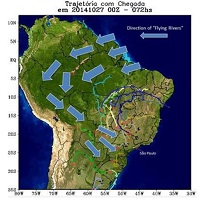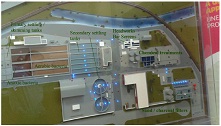Assignment:
Historically, transpiration from the Amazon rain forests produced large amounts of water vapor; trade winds blew that moisture towards the Andes mountains, which deflected the moisture back towards the area of southern Brazil, where sugar cane is grown. The moisture formed precipitation there regularly, making the area agriculturally productive.
For this reason, the windblown water vapor from the rain forests down to southern Brazil has been called "Flying Rivers".
But southern Brazil and cities nearby have been having a drought for several years. Scientists believe that this is due to deforestation of the Amazon rain forests.
1. Explain why deforestation would cause such a drought in this case.
2. Suggest three strategies to respond to this problem for the people living in the drought-affected areas, and for the industrial agriculture (sugar cane) happening in those areas.


3. Phosphate (PO 43- ) is necessary for life. What group of molecules in living things requires phosphate?
4. Extra phosphate in wastewater is harmful for life in bodies of water, such as lakes and rivers. Where does extra phosphate come from in the wastewater, and why is the extra harmful to lakes and rivers? Why?
5. The form of phosphate that is used in tap water (PO 43- ) is a negatively-charged molecule also called "orthophosphate". Orthophosphate is added to some cities' tap water, as part of the water treatment process. Why? Please give exact details about all of the chemicals that are involved.

Hint: look for the word "Lead" on the Moodle.
The diagram above shows the Burbank water reclamation plant on Lake Street which we visited.
6. Figure out the water's path through each labeled site in order. List the sites in order from when the water enters the process at first, to when the water exits the process at the end.
Hint: your list must contain seven items; use your memory or search the internet for diagrams of other water recycling plants
7. Make a hypothesis as to where any extra phosphates would be removed from the wastewater by this plant: name the spot(s) where extra phosphates will be removed, and explain your choice in as much detail as you can. Your answer is only valid if it is explained reasonably .
8. It is easy to measure the phosphate content in any sample of water by using some chemicals that change color when there is phosphate mixed in. Knowing this, how would you test your hypothesis from #7 above? Be as specific as you can.
9. The anoxic bacteria at the wastewater treatment plant consume a variety of our waste products in the water. They use nitrites and nitrates during this process, and release nitrogen gas into the air. What is this part of the nitrogen cycle called?
10. In the secondary settling tanks, cationic polymer is added to the water. Why is this useful, and how does this work?
Hint: if you need to do an internet search, do not read articles about "cationic polymerization"; you need information on cationic polymers used for water treatment. Hint: remember that + charges attract - charges, and remember what charge most molecules made by living things have.
11. Suppose you discover a new, large, clean source of heat energy. Draw a diagram or explain in great detail exactly how you can convert that heat energy into electricity. Hint: do not use thermoelectric materials, because they are not efficient for large-scale usage.
12. This video claims to show how much area within the United States must be covered in solar panels in order to generate electricity for the entire country's consumption.
Review youtube video: What Would It Take To Power The United States With Solar Energy?
The video uses the following facts:
1. In 2015, 0.6% of the United States' electrical energy was solar.
2. In order to make the other 99.4% also solar, we would need to generate 4.0 billion gigawatt-hours of solar electrical energy. Hint: 1 gigawatt-hour = 1,000 megawatt-hours. Hint: if you find a data table with numbers in thousands of megawatt-hours, those are equal to gigawatt-hours, because 1,000 megawatt-hours = 1 gigawatt-hour.
3. It takes 2.8 acres of land area covered in solar panels (photovoltaic panels) to generate 1 gigawatt-hour of solar electrical energy per year. Hint: 1 acre is about 4,000 square meters
4. 11,200,000 acres of solar panels can generate 4,000,000 GWh of energy in one year.
5. The area of the United States not including Hawaii is 1.9 billion acres.
6. The 11,200,000 acres which would need to be covered in solar panels is about 0.6% of the total 1.9 billion acres of land in the continental United States.
Please verify each facts that this video uses. Some will just require you to use a calculator. Many will require you to use the internet. Remember to use "site:gov" or "site:edu" in your Google searches to get the best chance of finding generally accepted facts. For each piece of information that you verify, paste the website where you found it, and give some opinion or comment about the fact. Make sure you express your answer in a way that is unique, so that your answer is not identical to someone else's. You must do your best to express your answer in a unique way in order to get credit for the work.
13. Use the correct data which you found, to calculate how many acres of land need to be covered in solar panels, in order to generate electricity for the entire United States for one year. Show your calculation here, in order to receive credit for this work.
14. Divide your answer in 13 over the total number of acres that are in the continental Untied States, and convert this to a %. What percent of the area of the continental United States must be covered in solar panels in order to generate enough electrical energy for the entire nation for one year?